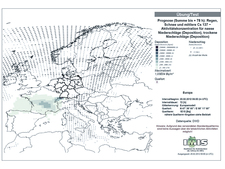-
Topics
subnavigation
Topics
Electromagnetic fields
- What are electromagnetic fields?
- Static and low-frequency fields
- Radiation protection relating to the expansion of the national grid
- High-frequency fields
- Radiation protection in mobile communication
Optical radiation
Ionising radiation
- What is ionising radiation?
- Radioactivity in the environment
- Applications in medicine
- Applications in daily life and in technology
- Effects
- What are the effects of radiation?
- Effects of selected radioactive materials
- Consequences of a radiation accident
- Cancer and leukaemia
- Genetic radiation effects
- Individual radiosensitivity
- Epidemiology of radiation-induced diseases
- Ionising radiation: positive effects?
- Risk estimation and assessment
- Radiation protection
- Nuclear accident management
- What happens in an emergency?
- Federal and state tasks
- In the event of an emergency
- Measuring networks
- Exercises for emergency situations
- Nuclear plant emergency response exercises
- Helicopter-borne Measurement Exercises
- Measurement exercises on the ground
- Measuring systems
- Nuclear accidents
- Defence against nuclear hazards
- Service offers
-
The BfS
subnavigation
The BfS
- About us
- Science and research
- Laws and regulations
- BfS Topics in the Bundestag
- Links
Nuclear plant emergency response exercises
- In order to successfully execute the protective measures to be taken in the event of an accident, the persons involved at all levels of crisis management must be adequately trained, qualified and prepared.
- Exercises are carried out regularly in order to train, review and further develop the measures scheduled by the nuclear power plant operator.
- Large-scale disaster control exercises at nuclear power plant sites are performed by the disaster control authorities at Länder level and at regional level. These exercises are carried out at intervals of several years because they are time-consuming and expensive.
- Based on bilateral contracts concluded within the scope of international co-operation, representatives from authorities of neighbouring countries are actively involved in exercises at nuclear plants located close to the border, or at least participate as observers.
In order to successfully execute the protective measures to be taken in the event of an accident, the persons involved at all levels of crisis management must be adequately trained, qualified and prepared. Therefore, great importance is attached to the training of operational staff within and outside a nuclear facility such as a nuclear power plant. This applies, in particular, to NPP staff preparedness to cope with an emergency at the plant.
Exercises scheduled by the operator
Exercises are carried out regularly in order to train, review and further develop the measures scheduled by the nuclear power plant operator. The operators’ exercises are generally performed once a year per NPP block. Typical scenarios are loss-of-coolant events in a nuclear power plant, external impact events (earth quake, floods) and power outage at the plant. Exercises at the plant sites are carried out as realistically as possible. NPP simulators are being used increasingly.
As a general rule, the annual exercises are limited to the NPP site. Exercises focussing on the cooperation with the producer’s crisis team, the KHT (Kerntechnischer Hilfsdienst) and the competent authorities for off-site emergency planning are run at larger time intervals.
Exercises by the authorities at national level
Large-scale disaster control exercises at nuclear power plant sites are performed by the disaster control authorities at Länder level and at regional level. These exercises are carried out at intervals of several years because they are time-consuming and expensive. In addition to the competent authorities and the professional advisory bodies, the plant operator also participates in these exercises. Potentially affected members of the public are normally not intended to be actively involved in the exercises.
Examples of such exercises for two Nuclear Power Plants in North Germany are the large-scale emergency protection exercises "Krümmel 2005" and "Brokdorf 2010".
The objectives of these exercises are, among others:
- To improve the communication and collaboration between the various authorities and organisations involved,
- Practical assignment of technicians and engineers outdoors in order to ensure that the measurement tasks are completed as required, as well as
- To test temporarily established emergency care centres providing decontamination and medical services for the general public.
Command post exercises (CORE 2009 and CORE 2014) were held in 2009 and 2014 for emergency management at the Federal Environment Ministry (Bundesumweltministerium, BMU) and at the Federal Office for Radiation Protection (Bundesamt für Strahlenschutz , BfS) to train the cross-border cooperation between the BMU headquarters, supported by the GRS and BfS. The next such exercise is planned for 2017.
Exercises at international level

![]() Forecast of the dispersion of radioactive substances after a fictitious accident at a nuclear power plant during an international exercise
Forecast of the dispersion of radioactive substances after a fictitious accident at a nuclear power plant during an international exercise
Based on bilateral contracts concluded within the scope of international co-operation, representatives from authorities of neighbouring countries are actively involved in exercises at nuclear plants located close to the border, or at least participate as observers. For example, a series of joint emergency response exercises was performed for the French nuclear power plant Cattenom in 2012 and 2013. In 2013, many German authorities and organisations joined the Swiss large-scale exercise GNU 2013 to review emergency preparedness and response at the nuclear power plant Leibstadt at the German-Swiss border.
BMU and BfS representatives in their respective fields are involved in regular exercises at EU level (ECURIE-exercises), IAEO level (CONVEX-exercises) and OECD/NEA level (INEX-exercises). In addition, supporting agencies (such as the GRS), other federal ministries and the competent Länder authorities take part, depending on the situation. In May 2016 a joint German-Dutch exercise has been conducted within the framework of the international series of exercises INEX-5.
State of 2017.06.27


